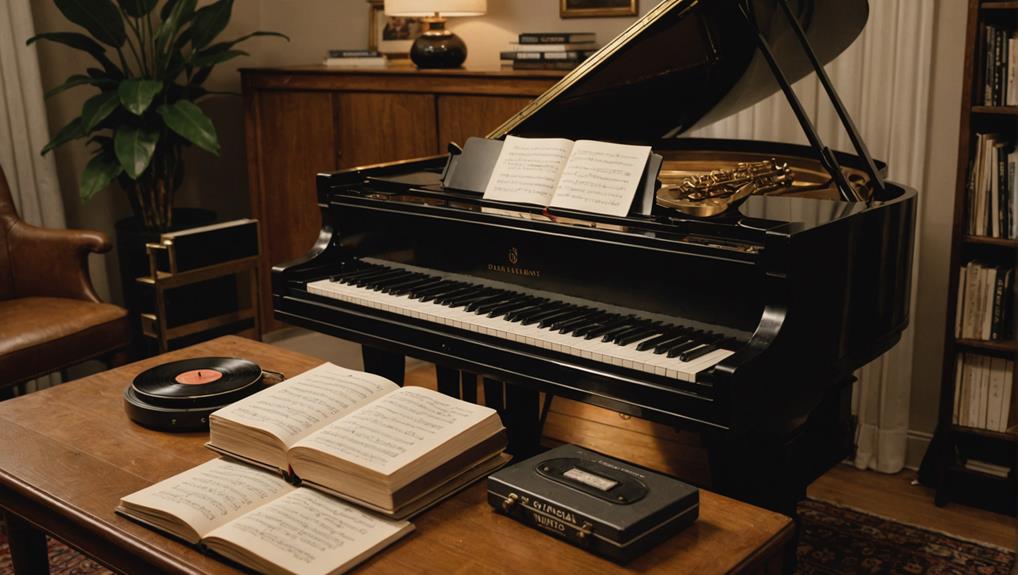To master the 6/4 time signature, start by understanding its basics: six beats per measure with a quarter note beating, and a compound duple meter with two groups of three beats. This foundation will help you navigate the unique rhythmic patterns found in classical, jazz, and folk music. Next, focus on counting and subdivisions. Emphasize six beats per measure, experimenting with various subdivision techniques and counting out loud to internalize the groove. Practice rhythmic reading by clapping patterns and subdividing beats. As you progress, apply these skills musically, enhancing musicality through dynamic performances and collaboration with others. With consistent practice, you’ll discover new rhythms and melodies.
Key Takeaways
- Emphasize six beats per measure, subdividing into two groups of three for rhythmic accuracy and internal pulse.
- Practice counting out loud and clapping rhythmic patterns in 6/4 to improve familiarity and rhythmic agility.
- Use a metronome set to 6/4 to maintain steady pulse and experiment with different subdivisions for groove mastery.
- Accent different beats and experiment with syncopated rhythms and offbeat accents to explore rhythmic textures and musical expression.
- Transition between 6/4 and other time signatures to enhance adaptability and apply skills musically through improvisation and collaboration.
Understanding 6/4 Basics
To grasp the essence of the 6/4 time signature, it’s important to understand that it comprises 6 beats per measure, with the quarter note taking the beat. This structure falls under a compound duple meter, characterized by two main groups, each consisting of three beats. This division is vital in offering the signature its distinctive rhythmic pattern, often found in genres like classical music, jazz, and some folk traditions, where a unique feel and groove are sought.
When you explore the time division, you realize that interpreting the 6/4 meter correctly hinges on recognizing these two groups of three beats. This understanding not only aids in grasping the basic framework but also in feeling the music’s pulse more intuitively. Each beat, then, isn’t just a count but a part of a larger rhythmic pattern that gives the music its flow and character.
Furthermore, beat interpretation in the 6/4 time signature involves a deeper level of rhythmic comprehension. You learn to navigate through the measures, emphasizing the primary beats to maintain a steady pulse, essential for both solo performance and ensemble synchronization. This foundational knowledge sets the stage for more advanced rhythmic explorations, ensuring you’re well-prepared to tackle the complexities of playing in 6/4 time.
Counting and Subdivisions
Mastering counting in a 6/4 time signature involves emphasizing the six beats per measure, setting the foundation for intricate rhythmic subdivisions. To enhance your rhythmic accuracy, you’ll need to explore various subdivision techniques within each measure. This practice not only sharpens your timing but also aids in internalizing the groove unique to 6/4.
Developing the ability to count and play simultaneously in 6/4 guarantees a seamless performance. Start by counting out loud, which is an essential step in internalizing the groove. As you become more comfortable, experiment with syncopated rhythms and accents to add depth to your playing.
Here’s a table to help you visualize some common subdivisions in 6/4 time:
| Subdivision Type | Example Count |
|---|---|
| Quarter Notes | 1 2 3 4 5 6 |
| Eighth Notes | 1 & 2 & 3 & 4 & 5 & 6 & |
| Triplet Feel | 1 trip let 2 trip let 3 trip let 4 trip let 5 trip let 6 trip let |
Rhythmic Reading Techniques
Having established a solid foundation in counting and subdivisions in 6/4 time, it’s now important to focus on rhythmic reading techniques to further your proficiency.
Start by practicing reading and clapping rhythmic patterns specifically designed for 6/4 time. This hands-on approach helps you develop a tangible feel for the signature’s flow, making it easier to internalize its unique cadence. Incorporate clapping exercises into your daily practice routine to build familiarity and agility within this time signature.
Next, focus on subdividing the beats into groups of 2 and 3. This method allows you to navigate the compound meter more effectively, ensuring you don’t lose your place within the measure. While practicing, always count out loud. Vocalizing the beats reinforces the rhythmic structure and helps maintain a steady pulse, which is essential in mastering 6/4.
Additionally, experiment with syncopated rhythms and accents. These variations challenge your understanding of rhythmic phrasing within the 6/4 framework, enhancing your musical expression.
Exercises for Mastery
Developing proficiency in the 6/4 time signature requires consistent practice with exercises designed to enhance your rhythmic agility and understanding. Start by practicing basic rhythmic patterns in 6/4 to build familiarity and comfort with the meter. This foundational step is essential for developing a solid base from which you can explore more complex rhythms.
Next, explore deeply into groove exploration by accenting different beats within the 6/4 time signature. This exercise helps you understand its unique feel and groove, enabling you to play with more expression and musicality. Utilize a metronome set to 6/4 to develop a strong internal pulse, ensuring your timing remains impeccable even as you experiment with these accents.
To add a layer of complexity, create exercises that involve switching between 6/4 and other time signatures. This improves your adaptability and versatility, equipping you to handle polyrhythmic challenges with ease. Experimenting with syncopated rhythms and offbeat accents within the 6/4 time signature further deepens your rhythmic understanding, offering a richer palette of rhythmic textures to work with.
Through these methodical exercises, you’ll gain mastery over the 6/4 time signature, ready to apply your skills musically with confidence and creativity.
Applying Skills Musically
Once you’ve honed your rhythmic skills in the 6/4 time signature, it’s time to apply these techniques musically to elevate your playing. Exploring melodic phrases that weave through the 6/4 bar lines can greatly enhance your musicality. By practicing tension and resolution, you emphasize different beats, creating a dynamic and expressive performance.
Improvisation is a powerful tool for understanding the 6/4 time signature’s musical possibilities. Experiment with improvisational techniques to discover new rhythms and melodies that feel natural in this unique time signature. Dynamic articulation plays an important role in bringing out the groove and feel of the 6/4 time signature, making your playing stand out.
Collaborating with other musicians opens up a world of collaborative musical contexts. Working in diverse styles within the 6/4 framework pushes you to adapt and refine your skills in real-time, providing invaluable experience.
| Skill | Application |
|---|---|
| Melodic Phrasing | Span phrases across 6/4 bars for enhanced musicality |
| Improvisation | Explore new rhythmic and melodic ideas |
| Collaboration | Engage in diverse musical contexts for growth |
Frequently Asked Questions
What Is a Trick for Understanding Time Signatures?
A trick for understanding time signatures is to focus on beat grouping and signature perception. You’ll grasp rhythms by identifying how beats are divided and how each signature shapes the music’s structure and flow.
How Do You Play 6 4 Time Signature?
To play in a 6/4 time signature, you’ll need to choose your instrument wisely and adopt effective practice techniques. Count ‘1 2 3 4 5 6’ or ‘1 2 3 1 2 3’ to master the rhythm.
How Can I Improve My Time Signature?
To improve your time signature skills, you’ll need to focus on rhythmic exercises and metronome practice. They’ll help you develop a deeper understanding and accuracy, ensuring you master any challenging rhythms you encounter.
How Do You Conduct a 6 4 Time Signature?
To conduct a 6/4 time signature, you’ll follow beat patterns of down, left, right, left, up, up. Mastering these conductor techniques guarantees musicians catch every beat, aligning perfectly with the music’s flow.
Conclusion
Now that you’ve explored the basics of 6/4 time, practiced counting, and tackled rhythmic reading, you’re on your way to mastery.
Remember, it’s all about delving into complex rhythms into manageable subdivisions and applying these skills musically.
Keep challenging yourself with new exercises and pieces. With dedication and patience, you’ll find that mastering 6/4 time adds a rich layer to your musical abilities.
So grab your instrument, immerse yourself in the music, and let your creativity flourish.




